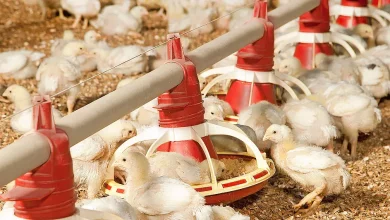Nutrigenomics: Nutrient Gene interaction in poultry
K. Shibi Thomas, R. Amutha, M. R. Purushothaman, P. N. Richard Jagatheesan,
S. Ezhilvalavan and V. Jayalalitha
Veterinary University Training and Research Centre,
Tamil Nadu Veterinary and Animal Sciences University (TANUVAS)
7/2, Kozhi Pannai Road, Kottapattu,Trichy – 620 023, Tamil Nadu
Feed constitutes a major portion of total production costs, therefore, improvement in the efficiency of feed utilization will reduce the amount of feed required for growth, which would directly reduce production cost, increase profitability, and subsequently reduce the amount of manure produced. Genetic variation in feed efficiency still exists in broiler chickens and needs to be exploited for genetic gain. However, current improvement methods for feed efficiency (FE) are limited in the rate of annual genetic improvement because the actual feed efficiency phenotypes (FEP) defined by genotypes or gene markers are unknown.
Energy and protein are the principal dietary constituents affecting live performance and muscle development in poultry and other animals. Also, the expression of various genes responsible for vital metabolic and regulatory functions of the body is dependent on the calorie-protein status of an individual.
Methionine is the first limiting amino acid in diets based on corn and soybean meal, and its deficiency is corrected by supplementation with synthetic methionine. Differences in the determination of methionine requirement for laying hens over the years is quite understandable due to major changes in genetics, nutrition and management which the birds are subjected to, besides the effects of age, type of diet and environmental conditions.
The determination of animal requirements of amino acids based on ideal protein concept allows reducing the levels of dietary crude protein with consequent industrial amino acids supplementation in crystalline form, generally maximizing protein utilization, reducing safety margins and consequently reducing the cost and emission of pollutants into the environment.
The advancements in the knowledge of the nutritional requirements of birds, in many phases, has constantly brought improvement to the quality of the diet; firstly in the sense of reaching maximum production, followed by the search for the lowest price of the feed and for the conversion into egg numbers. Thus, the great knowledge of the metabolism of protein in birds and the production of amino acids on a commercial basis have enabled the utilization of the concept of ideal protein for the formulation of diets.
This concept can be defined, theoretically, as the exact balance of the amino acids in the diet capable of meeting, without excess or deficiency, the requirements of all the essential amino acids for production and maintenance of birds, expressing them as percentage in relation to the lysine which is adopted as reference amino acid.
Lysine is the second limiting amino acid in diets for birds; its use, in lower or excessive levels, regarding the nutritional requirement of this nutrient in birds, may bring metabolic damages, which could compromise bird performance. For many decades, studies on the utilization of lysine, based on the concept of ideal protein in the diets of birds, have been developed, because of the great applicability, ease of utilization in the formulation of diets and low costs of the acquisition of L-lysine-HCl.
The growth rate is related to the feed efficiency and the deposition of muscle mass. The efficiency of a bird to convert food into muscle is related to the efficiency of energy production. Studies show that birds with lower ATP production because of lower efficiency of ATP production from substrate in the mitochondria have poor feed efficiency or feed conversion. The efficiency in energy production depends not only on the perfect coordination among the complexes of the respiratory chain, but also on a potent antioxidant system that protect mitochondria against the damage by the products generated during ATP production.
Methionine is required for the synthesis of glutathione, potent mitochondrial and cell antioxidant, further studies are needed to understand how the supplementation of methionine amino acid may influence the expression of the genes involved in energy production in mitochondria. Some important proteins were involved in the process of ATP production by the mitochondria: uncoupling protein (avUCP), adenine nucleotide translocase (ANT) and cytochrome c oxidase subunit III (COX III). Several researchers have demonstrated the relationship between the expression of genes encoding those proteins with feed efficiency in poultry.
Genes that affect either feed intake or body weight gain (BWG) may or may not necessarily affect feed efficiency. Thus, selection programs based on combinations of feed efficiency genotypes (FEG) or gene markers and the current traditional method will offer greater accuracy in breeding value estimation and consequently, a faster rate of genetic improvement. Some researchers have used quantitative trait loci (QTL) mapping to show complex genetic basis for feed efficiency. Feed efficiency QTL have been mapped in poultry. However, confident interval of QTL regions are usually large and further fine mapping is required to narrow the QTL region and subsequently identify the underlying genes. Genomic profiling is the first critical step to comprehensive understanding of the mechanisms that underlie the interaction of nutrition and the genome. It is well known that nutritional perturbations affect gene expression, and these perturbations have been used to establish gene networks. However, gene networks established from genetic mutation perturbations would be useful for genetic improvement since such functional mutations are the genetic raw material needed to establish trait genotypes. Limited studies have only been made on global gene expression profiling on feed efficiency. Microarray technology permits genome-wide differential gene expression analysis to uncover pathways and networks underlying feed efficiency.
The expression of growth-related hormones, such as insulin-like growth factor I (IGF-I) and growth hormone receptor (GHR), may be influenced by other factors, such as nutrition. Amino acids play a key role in regulating some cellular processes, such as the regulation of gene expression by mRNA modulation. Still, according to these authors, the cells are able to recognize the availability of amino acids and generate changes in translational signaling pathways, which are also regulated by hormones and growth factors.
Characteristics governing animal production, such as feed and reproductive efficiency, are expressed as a function of the animal genetics, the environment to which the animal is exposed and the interaction between these two factors.
Molecular nutrition has emerged as a new area in nutritional science following both advances in molecular biology and requirements for explaining the organism’s responses to nutrients at a molecular level. These include gene expression, signal transduction, and covalent modifications of proteins. Lactose operon theory, is the first example of gene regulation by a nutrient. Alterations of mRNA levels and in turn of the corresponding protein levels are critical parameters in controlling the flux of a nutrient or metabolite through a biochemical pathway. Applications of “omics”, such as genomics, transcriptome, proteome, and metabolome, facilitated molecular nutrition.
Growth and egg production traits of chicken are controlled by a series of major genes and/or quantitative trait loci (QTL). Analyses of genetic markers in animals could lead to discernment of the genetic architecture of quantitative traits. There are two basic methods of QTLs identification: approach of the candidate gene and whole-genome scanning. The candidate gene approach is an effective method for finding QTLs responsible for genetic variation in the traits of interest in agricultural animal species and calibrating whether specific genes are associated to economic traits in farm animals.
Selection for production traits in the poultry industry (broiler and layer) has resulted in a rapid improvement in animal performance. For broilers, the main selection pressure has been on growth rate, feed efficiency, and carcass traits, and in layers, the focus has been to increase egg production and quality. However, although several traits have been genetically improved, phenotypic and genetic variations still exist among chicken populations due to differences in selection practices imposed by different breeding programs; therefore, improvements are required in this regard.
To obtain considerable genetic gain in a selection program, it is necessary to understand the population structure and the genetic architecture of the traits to be selected for, in order to avoid deleterious effects. With the advantage of DNA investigation technologies, the ability to identify molecular markers that are used to construct linkage maps has improved, allowing the detection of hundreds of quantitative trait loci. Several studies using microsatellite markers have identified QTLs associated with production traits across the chicken genome. Other studies that have used single nucleotide polymorphism (SNP) markers have identified genetic associations and linkage with production, health, and behavioral traits in farm animals.
PUFA-enriched diets lead to significant changes in expression of several genes in the central nervous tissue, and these effects appear to be mainly independent of their effects on membrane composition, facilitating the understanding of the beneficial effects of the ω-3 PUFA on the nervous system. The mechanism underlying increased use of the amino acid glutamine to fuel anabolic processes in pancreatic ductal adenocarcinoma (PDAC) cells using metabonomics technology.
The science of nutrigenomics has begun to use information obtained from basic studies of the genome to evaluate the effects of diet and nutrient management schemes on gene expression. Preliminary studies have shown the value of such techniques and suggest that it will be possible to use specific gene expression patterns to evaluate the effects of nutrition on key metabolic processes relating to reproductive performance.
“Nutrigenomics” refers to study of the effects of nutrients on gene expression of an individual. The study of how genes and gene products interact with dietary chemicals to alter phenotype and how genes and their products metabolize nutrients is called nutritional genomics or “Nutrigenomics”. A new science seeking to understand the influence of dietary components on the Genome, Transcriptome, Proteome, and Metabolome. It is a science which study the effect of nutrients on the gene expression.
We are just entering the era of post genomic research, and molecular nutritional science is going to be of central interest as nutrients and other food components are the key factors in affecting gene and protein activities. The ultimate goals in the application of the powerful “omics” techniques are to expand our understanding of metabolism and nutrition and to determine how this relates to animal health and disease.



